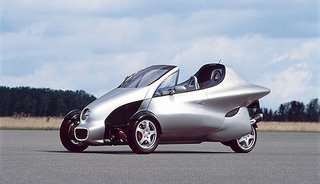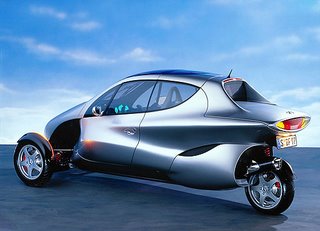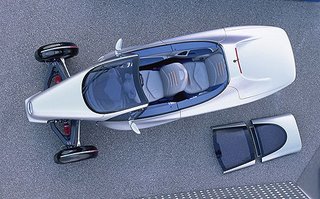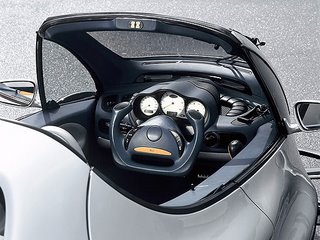Cornering dynamics of a motorcycle, safety of a passenger car
Body and front wheels tilt when negotiating bends



 Three wheels, two seats and a jet-design body – these are the visual characteristics of a research vehicle with which DaimlerChrysler surprised the public at the Frankfurt Motor Show in autumn 1997. The F 300 Life-Jet is aimed at a market segment which does not even exist yet, namely the niche between passenger cars and motorcycles. A new species of vehicle could establish itself here which combines everything the modern motorist requires for the perfect driving experience: the fresh-air fun of a convertible, the individuality of a roadster, the performance of a sports car, the comfort of a compact car and – not least – the safety of a Mercedes-Benz.
Three wheels, two seats and a jet-design body – these are the visual characteristics of a research vehicle with which DaimlerChrysler surprised the public at the Frankfurt Motor Show in autumn 1997. The F 300 Life-Jet is aimed at a market segment which does not even exist yet, namely the niche between passenger cars and motorcycles. A new species of vehicle could establish itself here which combines everything the modern motorist requires for the perfect driving experience: the fresh-air fun of a convertible, the individuality of a roadster, the performance of a sports car, the comfort of a compact car and – not least – the safety of a Mercedes-Benz.The F 300 Life-Jet offers all these attributes, and combines them with a further special feature which car drivers have previously lacked: the driving experience and cornering dynamics of a motorcycle. Accordingly this research vehicle reconciles seemingly contradictory characteristics: it is as safe and comfortable as a four-wheeled vehicle but as dynamic as a two-wheeler.
Active Tilt Control (ATC) lies at the heart of the F 300 technology. This system is based on the lightning-fast interaction between electronics, hydraulics and mechanics: sensors register the current driving situation and continuously feed the onboard computer with data indicating the yawing and linear speed of the vehicle, the acceleration, the current steering angle and the position of the hydraulic cylinder which steers the front axle. On the basis of this information the computer calculates the necessary angle of body tilt and sends the relevant control signals to the hydraulic system. As a result, the F 300 Life-Jet adopts a precisely calculated angle of tilt when negotiating bends, which reflects the current driving situation and therefore offers the best possible resistance to overturning. At maximum speed, for example, the ATC computer allows only a very small amount of body roll and provides additional stability, but quickly allows the active control system to select a maximum angle of tilt of 30 degrees at non-motorway road speeds.
Cornering speed of a motorcycle
By means of this active tilt on bends, the F 300 developers are able to compensate a large proportion of the lateral forces which act on the vehicle and affect its resistance to overturning. The centre of gravity is shifted to the inside of the bend, substantially compensating the tendency to overturn and making high cornering speeds possible. The maximum lateral acceleration of the F 300 Life-Jet is 0.9 g – a level normally only reached by experienced motorcyclists. The loads acting on the occupants remain low, however. Owing to the tilting effect on bends, they only need to resist the centrifugal forces to a very small extent – an advantage that decisively improves ride comfort.
The engine and transmission of the three-wheeled study are in a space-saving position between the interior and the rear wheel. The 1.6-litre power unit adopted from the A-Class has an output of 75 kW/102 hp and accelerates the F 300 Life-Jet from standstill to 100 km/h in just 7.7 seconds. The maximum speed is 211 km/h. This innovative three-wheeler therefore achieves the performance levels of much more powerful sports cars and roadsters.
Aluminium chassis with removable roof sections
The chassis of the two-seater is made from aluminium and weighs only 89 kilograms. Special features of the body include an upward pivoting door on the driver’s side, a rearward pivoting door on the passenger side and a fixed roof of aluminium and transparent plastic which makes the F 300 Life-Jet a genuine all-season vehicle. The two roof sections can be easily removed and stowed in a compartment above the rear wheel, converting the three-wheeled study into an open-top roadster.
An innovative headlamp with three reflector areas and two bulbs provides maximum road illumination when negotiating bends. The headlamp electronics are linked to the ATC computer, pivoting the headlamp according to the body tilt and switching on a special cornering light when required. This increases the area illuminated by the dipped headlamp beam by more than 80 percent.
New, space-saving neon lighting technology is used for the indicators, brake lights and side lights of the research vehicle. The driving lights are switched on automatically by a sensor when darkness falls or the vehicle enters a tunnel. Mercedes passenger cars have been equipped with this system since 1998.
© Source: original article on seriouswheels.com